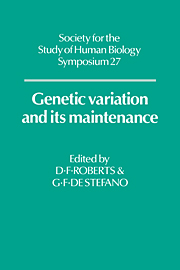Book contents
- Frontmatter
- Contents
- Preface
- Part I Genetic Diversity - Its Dimensions
- Part II Genetic Diversity - Its Origin and Maintenance
- Human genetic diversity in south-east Asia and the western Pacific
- Malaria-protective alleles in southern Africa: relict alleles of no health significance
- The genetic origin of the variability of the phenotypic expression of the Hb S gene
- Origin and maintenance of genetic variation in Black Carib populations of St. Vincent and Central America
- Historical and demographic factors and the genetic structure of an Afro-American Community of Nicaragua
- Migration and genetic polymorphisms in some Congo peoples
- Population structure studies and genetic variability in humans
- Inbreeding and the incidence of recessive disorders in the populations of Karnataka, South India
- Genetic diversity at the albumin locus
- GENETIC DIVERSITY - APPLICATIONS AND PROBLEMS OF COMPLEX CHARACTERS
- Index
Genetic diversity at the albumin locus
Published online by Cambridge University Press: 05 March 2012
- Frontmatter
- Contents
- Preface
- Part I Genetic Diversity - Its Dimensions
- Part II Genetic Diversity - Its Origin and Maintenance
- Human genetic diversity in south-east Asia and the western Pacific
- Malaria-protective alleles in southern Africa: relict alleles of no health significance
- The genetic origin of the variability of the phenotypic expression of the Hb S gene
- Origin and maintenance of genetic variation in Black Carib populations of St. Vincent and Central America
- Historical and demographic factors and the genetic structure of an Afro-American Community of Nicaragua
- Migration and genetic polymorphisms in some Congo peoples
- Population structure studies and genetic variability in humans
- Inbreeding and the incidence of recessive disorders in the populations of Karnataka, South India
- Genetic diversity at the albumin locus
- GENETIC DIVERSITY - APPLICATIONS AND PROBLEMS OF COMPLEX CHARACTERS
- Index
Summary
INTRODUCTION
Although documentation of genetic diversity in man has been long continuing, the mechanisms maintaining this diversity, in particular selective mechanisms, have proved difficult to identify. The role of balancing selection through heterozygote superiority in fitness was the first to be demonstrated in the resistance to Plasmodium falciparum malaria by the sickle cell variant in the haemoglobin polymorphism, and similar mechanisms have been proposed regarding the thalassaemia trait and G6PD deficiency. Other examples of the role of selection in maintaining genetic diversity are still relatively few. Many authorities maintain that the majority of polymorphisms are transient or selectively neutral. Using the assumption of neutralism regarding the albumin molecule, Sarich and Wilson proposed a molecular clock to estimate rates of evolution of, and phylogenetic distances between, mammalian species. However, it seems that sufficient accurate fundamental study of the functional differences between proteins has not yet been undertaken to allow this assumption to be accepted. One reason for this is that, until recently, such study may have been hindered by lack of sophisticated technical equipment. With the advent of more accurate spectrophotometry and, especially, fast protein liquid chromatography (FPLC) which allows for isolation of the protein in question, such study of functional differences in proteins has become possible.
ALBUMIN VARIATION
Albumin is of interest because the very conservative evolution of the molecule, and the rarity of albumin polymorphisms in primates, point to a possible special nature to those albumin polymorphisms which do exist. There is also a strong geographic specificity to the distribution of the polymorphic variants.
- Type
- Chapter
- Information
- Genetic Variation and its Maintenance , pp. 229 - 236Publisher: Cambridge University PressPrint publication year: 1986



